The Scented Dilemma: How Scented Candles and Air Fresheners Impact Indoor Air Quality
Many appreciate walking into a beautifully scented room, and the enjoyment of pleasant fragrances that instantly uplift our mood. Scented candles and air fresheners have become incredibly popular, offering a quick and convenient way to enhance the ambiance of our homes. However, have you ever stopped to consider the potential impact these fragrant products can have on your indoor air quality?
Understanding Indoor Air Quality
Indoor air quality refers to the condition of the air within buildings and structures. It is crucial to maintain good indoor air quality as we spend a significant amount of our time indoors. According to a study done by the EPA, the average American spends upwards of 90% of their time indoors. Poor indoor air quality can lead to various health issues and even long-term complications.
Immediate effects of unhealthy indoor air quality can be things such as irritation of the eyes, nose, and throat, dizziness or feeling lightheaded, and fatigue. If left unmanaged, long-term effects can cause respiratory and heart diseases. With this in mind, it is important to be aware of the products in your home and how they will impact your air.
The Hidden Dangers of Scented Candles
Scented candles are widely used to create a cozy and fragrant atmosphere. However, most scented candles are made from paraffin wax, made from petroleum. When burned, these candles can release potentially harmful chemicals such as benzene and toluene into the air. These chemicals can irritate the respiratory system, trigger allergies, and even have carcinogenic effects in high concentrations.
Additionally, the fragrances used in scented candles often contain synthetic compounds that can emit volatile organic compounds (VOCs) when heated. VOCs can contribute to indoor air pollution and may cause headaches, dizziness, and eye and throat irritation, especially for individuals with sensitivities.
The Impact of Air Fresheners
Air fresheners come in various forms, including aerosols, plug-ins, and sprays. While they offer a quick solution for masking malodors, they can also negatively impact indoor air quality. Many air fresheners contain chemicals like formaldehyde, phthalates, and terpenes. These substances can release VOCs and particulate matter when dispersed into the air, leading to respiratory issues and allergic reactions.
Formaldehyde, a common ingredient in air fresheners, is known to irritate the eyes, nose, and throat. Long-term exposure to formaldehyde has been linked to increased risks of asthma and certain types of cancer.
Finding Safer Alternatives
If you still crave a scented environment, don’t fret! There are safer alternatives available that can help improve indoor air quality while still getting to enjoy your favorite aromas. Consider the following options:
- Beeswax or soy-based candles
- Essential oil diffusers
Look for candles made from natural materials like beeswax or soy wax. These options burn cleaner and produce fewer toxins compared to paraffin candles. Instead of using air fresheners, consider using essential oil diffusers to disperse natural fragrances. Ensure you choose high-quality, pure essential oils free from synthetic additives.
When possible, use natural air purifiers like plants, which can help filter out toxins and improve indoor air quality. Plants such as peace lilies, spider plants, and Boston ferns are known for their air-purifying properties.
To learn more about VOCs and other common VOC sources: CLICK HERE


